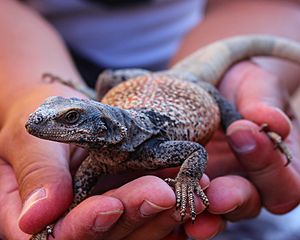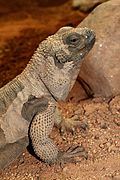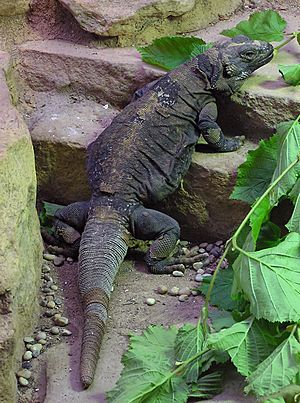Chuckwalla facts for kids
Quick facts for kids ChuckwallaSauromalus |
|
|---|---|
 |
|
| Common chuckwalla, S. ater (male) | |
 |
|
| Common chuckwalla, S. ater (female) | |
| Scientific classification |
|
| Kingdom: | Animalia |
| Phylum: | Chordata |
| Class: | Reptilia |
| Order: | Squamata |
| Suborder: | Iguania |
| Family: | Iguanidae |
| Genus: | Sauromalus Dumeril, 1856 |
| Species | |
|
Sauromalus ater (formerly Sauromalus obesus) |
|
Chuckwallas are large lizards that mostly live in the hot, dry areas of the southwestern United States and northern Mexico. Some also live on islands near the coast. There are six different types, or species, of chuckwallas. They all belong to the group called Sauromalus. These lizards are part of the Iguanidae family, which includes iguanas.
Contents
What's in a Name?
The scientific name for chuckwallas, Sauromalus, comes from two ancient Greek words. Sauros means "lizard." Omalus means "flat." The common name "chuckwalla" comes from words used by Native American tribes like the Shoshone and Cahuilla. The Spaniards later wrote it down as chacahuala.
Types of Chuckwallas
There are six main types of chuckwallas alive today. Each one lives in a specific area.
| Image | Scientific name | Common name | Where they live |
|---|---|---|---|
 |
Sauromalus ater | Common chuckwalla | Eastern California, Utah, Arizona, Nevada, and south to Baja California and Sonora. |
| Sauromalus australis | Peninsular chuckwalla | Southeastern Baja California and eastern Baja California Sur in Mexico. | |
 |
Sauromalus hispidus | Angel Island chuckwalla | Isla Ángel de la Guarda and 10 smaller islands in the Gulf of California. |
| Sauromalus klauberi | Santa Catalina chuckwalla / Spotted chuckwalla | Baja California. | |
| Sauromalus slevini | Monserrat chuckwalla | Islands in the Sea of Cortés: Isla del Carmen, Isla Coronados, and Isla Monserrate. | |
 |
Sauromalus varius | Piebald chuckwalla or Pinto chuckwalla | Only on San Esteban Island in the Gulf of California. |
What Do They Look Like?
Chuckwallas are strong, wide lizards. Their bodies are quite flat in the middle. They have big bellies and thick tails that end in a blunt tip. Their skin is loose, especially around their necks and sides. It is covered in small, bumpy scales.
The common chuckwalla (Sauromalus ater) can grow to about 15.75 inches (40 cm) long. Some island types, like the San Esteban chuckwalla (Sauromalus varius), can be much bigger. They can reach up to 30 inches (76 cm) in length!
Chuckwallas show sexual dimorphism. This means males and females look different. Males often have reddish-pink, orange, yellow, or light gray bodies. Their heads, shoulders, and legs are black. Females and young chuckwallas have bodies with spots or stripes. These can be light and dark gray or yellow. Males are usually bigger than females. They also have special pores on their inner thighs called femoral pores. These pores make a substance that helps them mark their territory.
Where Do They Live and What Do They Eat?
Chuckwallas live in the Sonoran Desert and Mojave Desert areas. The common chuckwalla (S. ater) lives in the most places. You can find it from southern California to southern Nevada, Utah, and western Arizona. It also lives south into Baja California and northwestern Mexico. The peninsular chuckwalla (S. australis) lives in the eastern part of the southern Baja California Peninsula.
Other types of chuckwallas live only on islands. This means they have much smaller areas where they can be found. For example, the Angel Island Chuckwalla (S. hispidus) lives on Isla Ángel de la Guarda and nearby islands. Two rare and endangered species are the Montserrat chuckwalla (S. slevini) and the San Esteban chuckwalla (S. varius).

Chuckwallas like to live in lava flows and rocky places. These areas often have plants like creosote bush that can live in dry conditions. These lizards can be found in places up to 4,500 feet (1,370 meters) high.
Chuckwallas are mostly herbivores. This means they eat plants. They munch on leaves, fruit, and flowers from annual and perennial plants. Sometimes, they might eat insects too. They seem to really like yellow flowers, like those from the brittlebush.
How Do They Behave and Reproduce?
Chuckwallas are harmless to people. They usually run away if they feel threatened. If a chuckwalla is bothered, it will quickly wedge itself into a tight crack in a rock. Then, it will puff up its lungs to make itself bigger. This helps it get stuck firmly in the crevice, making it hard for predators to pull it out.
Male chuckwallas can be territorial. If there is plenty of food, they often form a group where the biggest male is in charge. Chuckwallas use different ways to show who is boss and defend their space. They use colors, do "push-ups," bob their heads, and open their mouths wide to communicate.
Chuckwallas are diurnal animals. This means they are active during the day. Since they are ectothermic (cold-blooded), they need the sun to warm up. They spend a lot of their mornings and winter days basking in the sun. These lizards are very good at living in the desert. They can be active even when temperatures reach up to 102°F (39°C). Young chuckwallas come out first when temperatures are around 90°F (32°C). Chuckwallas hibernate (sleep through) the colder months and come out in February.
Mating season for chuckwallas is from April to July. Females lay between five and 16 eggs from June to August. The baby chuckwallas hatch in late September. Chuckwallas can live for 25 years or even longer!
Chuckwallas and People
The Comcaac (Seri) are a Native American group. They thought the Angel Island chuckwalla was an important food source. It is believed they moved these lizards to many islands in Bahia de los Angeles. This way, they would have food when they needed it.
See also
 In Spanish: Chacahualas para niños
In Spanish: Chacahualas para niños
More Information
- ARKive - images and movies of the San Esteban Island chuckwalla (Sauromalus varius)
www.chuckwalla-reptiles-tirol.at
Images for kids








